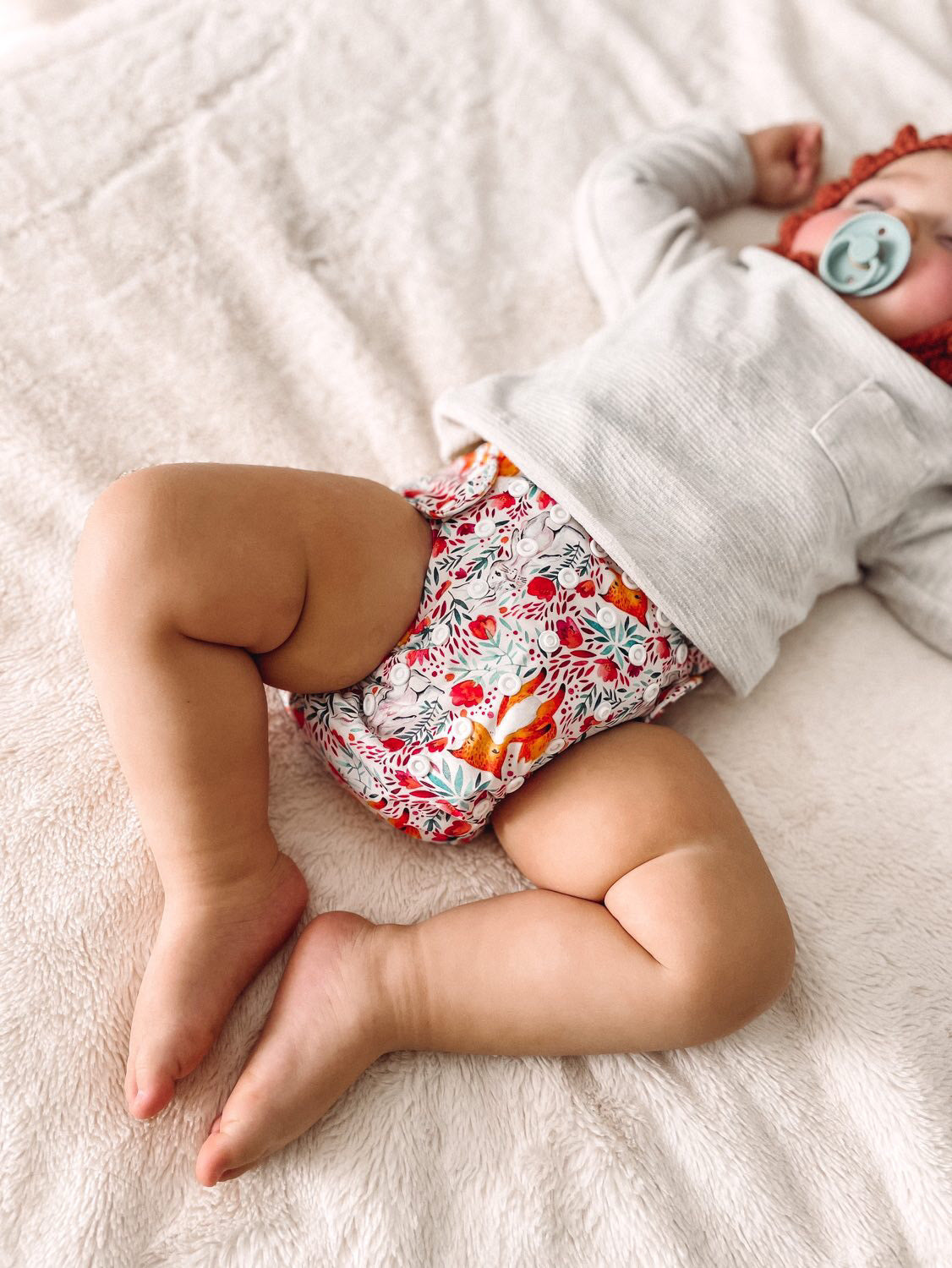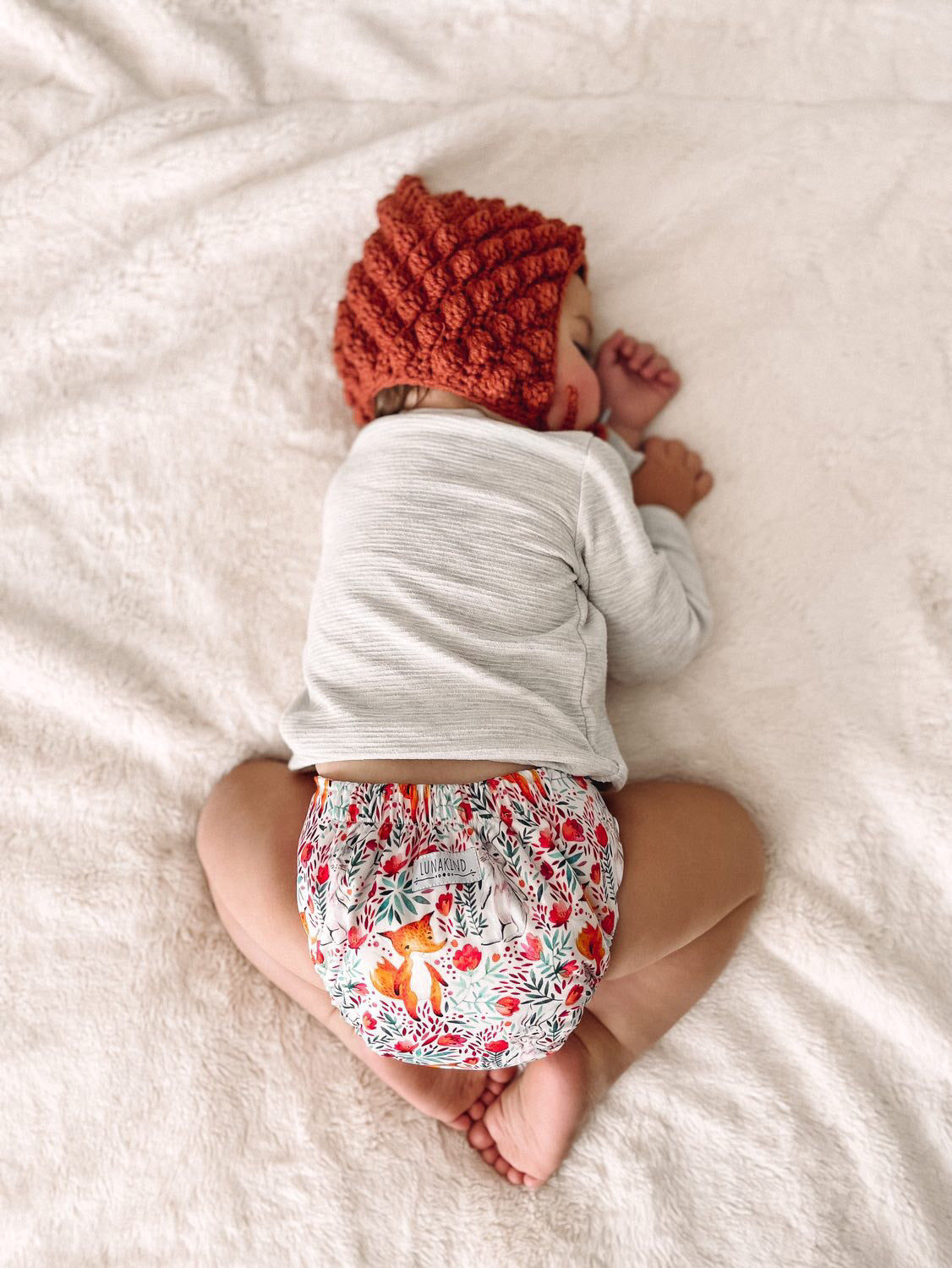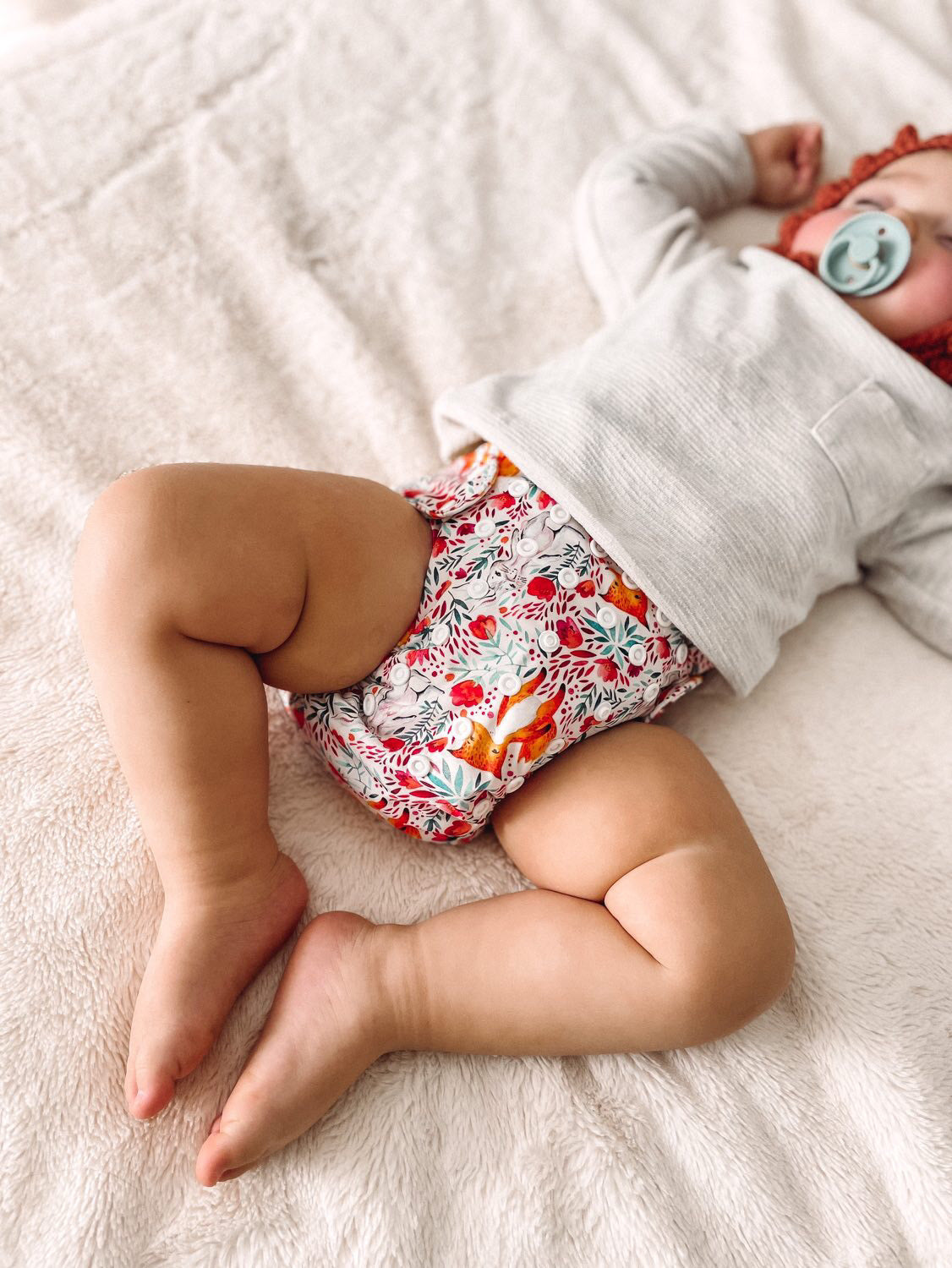Cloth diapers vs disposable diapers
Cloth diapers vs disposable diapers: Discover all the pros and cons of cloth diapers and disposable diapers. Here you can find out everything about costs, energy consumption and ecological balance. You'll also get information about the cheapest and healthiest disposable diapers!
You start here
Cloth diapers vs disposable diapers
Cost comparison of cloth diapers and disposable diapers
Is the ecological balance of cloth diapers really better? "Cloth diapers aren't any more sustainable; you have to wash them regularly, which uses up a lot of water." Yes, you still hear that, but how much water and energy is actually used when washing cloth diapers? In the following part we will examine the energy consumption of cloth diapers and make a comparison between cloth diapers and disposable diapers in terms of their environmental impact and cost.
Cloth diapers:
For the washing process of cloth diapers we need an average of 50 liters of water and have an electricity consumption of 1 kWh per load. A load of detergent costs €0.17.
- Water consumption per year: 50 liters/load × 122 washing days = 6,100 liters per year
- Electricity consumption per year: 1 kWh/load × 122 washing days = 122 kWh per year
- Detergent costs per year: €0.17 x 122 washing days = €20.74
The average cost of electricity is around €0.30 per kWh. So the electricity costs for 3 years are:
122 kWh/year × €0.30/kWh ×3 years = €109.80
The average cost of water is around €4 per 1,000 liters. So the water costs for 3 years are:
6,100 liters/year × €4/1000 liters × 3 years = €73.20
The cost of the detergent for 3 years is: €62.22
The purchase costs for cloth diapers, absorbent pads and wetbags and reusable changing mats amount to €650. We also need diaper fleece for around €220.
Disposable diapers:
Suppose we use 6 disposable diapers daily with a unit price of €0.25 per diaper for a period of 3 years:
- Cost of diapers per year: 6 diapers/day × €0.25/diaper × 365 days = €547.50 per year
- Ø Annual garbage fee: €150
Added to this are the costs for disposable documents. Here one deposit is used every two days. The costs for 3 years amount to:
- €0.17/disposable pad x 183 days x 3 = €93.33
The total cost of disposable diapers for 3 years is:
€547.50/year × 3 years + €150 + €93.33 = €1,935.83
Conclusion:
Cloth diapers:
- Water consumption per year: 6,100 liters
- Electricity consumption per year: 122 kWh
- Electricity costs for 3 years: €109.80
- Water costs for 3 years: €73.20
- Detergent costs for 3 years: €62.22
- Purchase costs for cloth diapers, absorbent pads, wetbags and reusable changing mats: €650
- Cost of diaper fleece: €220
- Total costs for 3 years: €109.80 (electricity) + €73.20 (water) + €62.22 (detergent) + €650 (purchase costs) + €220 (diaper fleece) = €1,115.22
Disposable diapers:
- Total costs for 3 years: €1,935.83
Savings on cloth diapers compared to disposable diapers of €820.61
Conclusion :
The comparison shows that cloth diapers are significantly cheaper than disposable diapers over a three-year period. Although the initial cost of cloth diapers is higher, the operating costs (electricity and water) and the costs of accessories overall are significantly lower than the total costs of disposable diapers. Additionally, the long-term environmental benefits of cloth diapers in terms of waste reduction and resource conservation can also be considered.
And one more thing: Did you know that you can save yourself the increased initial purchase costs with us? We offer 0% financing with PayPal, so that instead of paying around €650 once, you simply pay around €30 a month for 24 months.
Cloth diapers vs disposable diapers: electricity and water consumption
coming soon
Cloth diapers vs disposable diapers: The ecological balance
coming soon

Which diaper is the best?
The diaper that suits you, your child and your situation. You can even combine cloth diapers and disposable diapers! With just one cloth diaper per day, you save more than 1,000 diapers of waste per child.
Disposable diapers
Information about disposable diapers
The cheapest disposable diaper
Disposable diapers are available in a wide price range. The price per diaper varies between €0.13 and €0.56. This price difference depends on various factors including size, package size, brand and ingredients. With an average need of around 6,000 diapers per child over a period of three years, the total cost of disposable diapers can be between €1,300 and €4,000.
The healthiest disposable diaper
When choosing disposable diapers, not only the price but also the composition of the diapers is important. Some manufacturers pay particular attention to high-quality ingredients, but almost all of them have one thing in common: the superabsorbent they contain.
This superabsorbent is an essential ingredient that helps absorb liquid effectively and keep baby dry. The superabsorbent usually consists of synthetic polymers that are able to absorb 30 times as much liquid and convert it into gel.
The synthetic polymers in superabsorbents often consist of a combination of different chemical ingredients, including acrylic acid and sodium acrylate. These chemicals allow the superabsorbent to efficiently absorb and bind liquid, helping to reduce the appearance of moisture in the diaper. However, this also leads to the skin's natural fluid barrier being disrupted, which can dry out the skin.
It is important to note that the use of chemicals in disposable diapers is controversial. Some parents are concerned about the potential effects of chemicals on their baby's sensitive skin and may prefer natural or biodegradable alternatives such as cloth diapers.
Additionally, the plastic in disposable diapers can cause skin irritation. Plastic materials can irritate the baby's skin and hinder the natural exchange of moisture, which can lead to skin problems such as redness, rashes and inflammation. Disposable diapers do not allow the skin to breathe and create a humid microclimate in the diaper that can increase skin irritation. Research has shown that the climate in disposable diapers can be up to 2 degrees warmer than in cloth diapers, increasing the risk of skin irritation.
So what is the healthiest disposable diaper? There is only one manufacturer we know of that currently produces diapers without chemical superabsorbents and only uses 15% plastic. However, this diaper also costs €0.56, which is associated with an average cost of €4,000 per child.
Disposable diapers: The best price-performance ratio
coming soon

The best for your baby's skin...
Every baby reacts differently to diapers, even if they are made from high-quality materials. Parents should therefore carefully monitor their baby's skin to ensure that it tolerates diapers well. If necessary, they should look for signs of allergies to ensure that the baby is comfortable in their diaper.
The best cloth diapers
Advantages of cloth diapers
Better for health
Delicate, delicate, baby bottom
Cloth diapers are better for your baby's delicate skin! Since they are free of chemicals and do not contain superabsorbents, the skin is less irritated and does not dry out as quickly. Another advantage is that cloth diapers are permeable to air. This means more oxygen automatically reaches your baby’s skin.
No experiments, no chemistry
Disposable diapers contain a superabsorbent. This consists of chemicals and can absorb up to 20x its own volume. Since it has the ability to absorb liquids, it also absorbs the natural moisture of the skin layer. This causes the skin to dry out and become irritated. In contrast, cloth diapers are chemical-free and breathable.
What a hip swing, baby!
Cloth diapers are better for hip development. Since they are cut wider in the crotch, they automatically ensure that the legs are in a spread position. This ensures that your baby's hips can develop better.
Diaper who? We don't know diaper rash!
With cloth diapers, skin irritations occur significantly less often. The breathable membrane of the diapers ensures that enough air gets to the skin. In contrast, the climate in disposable diapers is warm and humid: the temperature in disposable diapers is up to two degrees higher. In addition, contact with urine nourishes the baby's skin in a natural way. What is added to many creams is naturally present here: urea. Urea binds moisture in the upper layer of skin and ensures that the skin remains supple. This means that skin rashes rarely occur with cloth diapers.
Financial aspects
Cash is king
Diapers are usually not included in the purchase costs for the initial equipment. But the cost factor is immense: disposable diapers cost you around €2,000. You can be all the more pleased that you can save more than €1,000 in cash with our diapers. You can find a cost comparison here . With cloth diapers, you buy diapers for the entire diaper changing time: That's around 6,000 disposable diapers! To make the investment easier for you, you can easily pay in installments with 0% financing!
More comfort
Bye, bye poop ash!
All young parents know it: the poop ashes. Liquid stools cause unpleasant surprises, especially in newborns. You don't have this with cloth diapers: The wide back elastic prevents leaks. In addition, the ergonomic shape of our hemp inserts ensures that liquid stool is caught and quickly absorbed - perfect for smaller babies.
And babies smell so good!
We all love it: the smell of babies. This also includes the smell of diapers! But do diapers have to stink? No! You won't believe it, but cloth diapers smell less than disposable diapers. Because they are stored in air-permeable wet bags, bacteria cannot multiply as quickly. A wash every 2-3 days ensures that your diapers don't smell.
Environmental Impact
There Is No Planet B
With cloth diapers you save a lot of waste: In total, that's around 1.5 tons of diaper waste! That corresponds to a mountain of 6,000 disposable diapers. Since a diaper takes around 500 years to completely decompose, you help the environment by using cloth diapers. We also use existing resources in production: the waterproof membrane in our diapers consists of more than 95% recycled materials.
More fun & self-efficacy
Let's have fun
This is guaranteed: you will have more fun changing diapers! The beautiful designs are addictive. Both you and your child will have favorite diapers and you can involve your child even better in the changing process.
They grow up so quickly
Children who are changed with cloth diapers usually dry faster. This is because they feel the moisture of the diaper. This way they get wetness feedback and notice when they wet their diaper. This feeling is missing from disposable diapers because the superabsorbent absorbs the urine so quickly.


